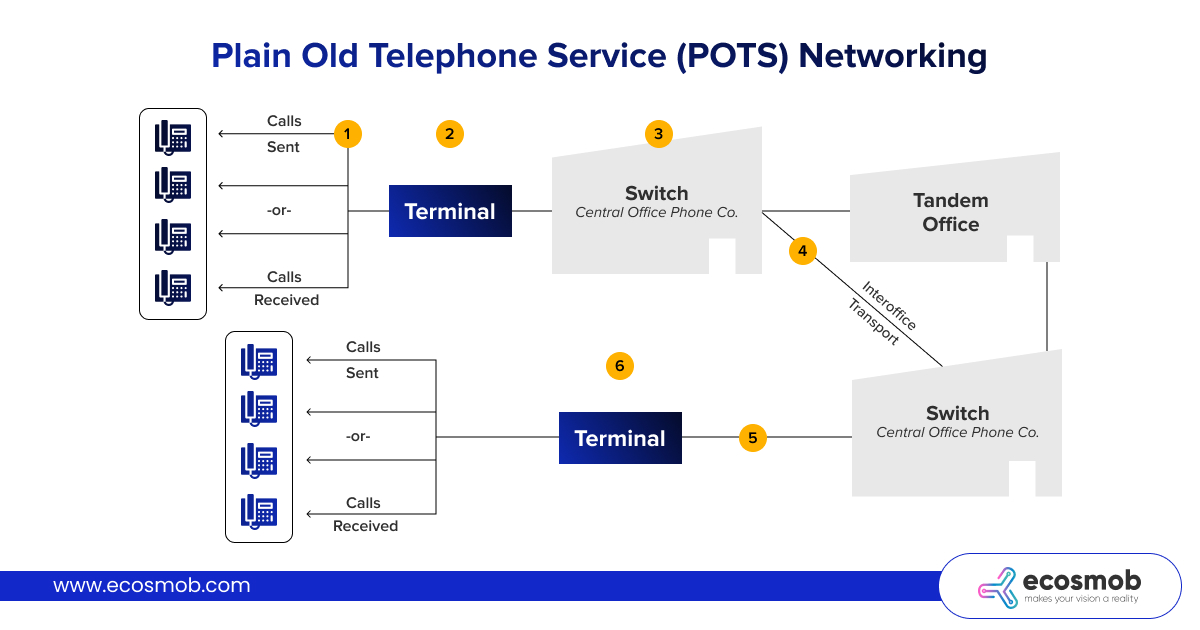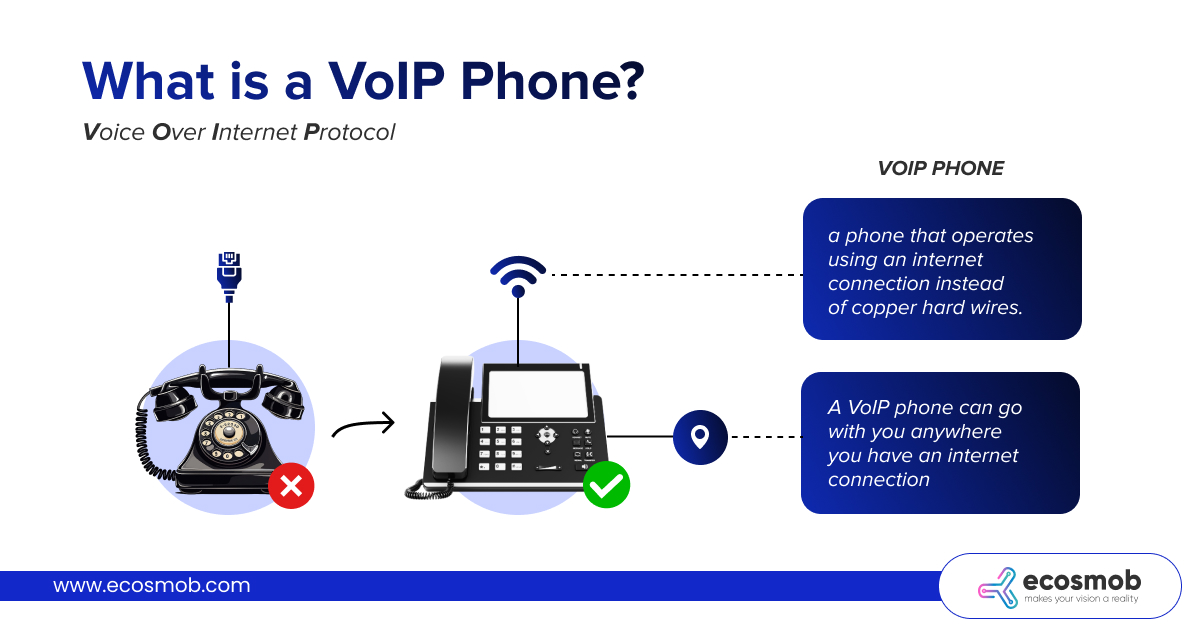The article explores the key differences between POTS and VoIP in terms of reliability, features, and scalability. Whether you’re considering a switch to VoIP or evaluating POTS for business needs, this guide helps you make an informed decision.
Ever wondered if your old-school landline is still the best option in today’s fast-paced digital world?
Or are you considering switching to VoIP but unsure whether it’s the right move?
If so, you’re not alone!
The debate of POTS vs. VoIP has been ongoing, especially for businesses looking for a reliable communication system. In this blog, we’ll break down the major differences between POTS and VoIP in terms of reliability, features, and scalability so you can make the best choice for your needs.
What is POTS in Telecommunication?
POTS, or Plain Old Telephone Service, is the original analog telephone system that has been around since the late 19th century. It operates over copper wire networks and provides a direct, dedicated circuit for voice communication.
Every time you make a call, the system establishes a continuous electrical connection between you and the person on the other end.
POTS lines were once the gold standard for voice communication, but as technology advanced, digital solutions like VoIP (Voice over Internet Protocol) emerged, raising the question –
POTS vs VoIP – which one is better?
How POTS Works?
POTS transmits voice signals as electrical pulses through a dedicated copper line. When you dial a number, the system routes the call through a series of switches until it reaches the intended recipient. The simplicity of this system ensures high call clarity and reliability, making it a preferred choice for emergency services and alarm systems.
 Key aspects of how POTS works:
Key aspects of how POTS works:
- Dedicated Copper Lines – Calls travel over physical wires, ensuring stable connections.
- Analog Signal Transmission – Voice signals are converted into electrical waves.
- Circuit-Switched Network – A direct line is established between two callers.
- Power Independence – Unlike VoIP, POTS continues to function during power outages.
- Limited Features – Unlike VoIP, POTS does not support video calls, conferencing, or advanced call management features.
However, as businesses and individuals shift towards digital solutions, many are considering POTS line replacement options and looking into how to switch landline (POTS) to VoIP for enhanced features and cost savings.
Now that we’ve covered POTS, let’s talk about its digital counterpart – VoIP. If you’ve ever made a call using Skype, Zoom, or WhatsApp, you’ve already experienced VoIP in action.
The White House switched from POTS to VoIP in the early 2000s!
But what exactly is it, and how does it work?
Is your business ready to switch to VoIP, or are you sticking with POTS? Let us know your biggest concerns.
What is VoIP Technology?
VoIP, or Voice over Internet Protocol, is a technology that enables voice calls over the internet instead of traditional copper wires. Unlike POTS, which relies on physical infrastructure, VoIP converts your voice into digital data and transmits it over an internet connection.
As businesses and individuals seek cost-effective, flexible solutions, many are comparing POTS vs VoIP differences to determine the best option for their needs.
Even astronauts make VoIP calls from space! The International Space Station (ISS) connects to Earth using internet-based calling.
How VoIP Works
VoIP technology takes your voice, digitizes it, and sends it as data packets over the internet. Here’s a step-by-step breakdown:
- Voice Conversion – Your voice is converted into digital signals using a codec.
- Data Transmission – These digital packets travel over an IP network (internet or private data network).
- Routing Calls – The packets are reassembled at the recipient’s end to recreate your voice in real-time.
- Internet Dependency – Unlike POTS, VoIP relies on a stable internet connection to function.
 Also, if you were wondering who a VoIP caller is or can be, here is your answer to it.
Also, if you were wondering who a VoIP caller is or can be, here is your answer to it.
But Why Are Businesses Switching to VoIP?
Companies are increasingly looking to replace POTS with VoIP solutions due to VoIP’s advanced capabilities. Some key comparisons are –
- Scalability
- Reliability and,
- Features
Let’s take a brief look at it!
How do POTS vs VoIP Differ on the Basis of Scalability?
Scalability is a major factor in the POTS vs VoIP differences debate –
- POTS – Scaling up with POTS is a challenge. Each new phone line requires additional physical wiring and hardware, leading to higher costs and installation delays. This limitation makes it difficult for growing businesses to adapt quickly.
- VoIP – On the other hand, VoIP offers seamless scalability. Adding a new user is as simple as creating an account and assigning a phone number. Whether you’re a startup adding a few employees or a large enterprise expanding globally, VoIP can scale with minimal effort and cost.
For businesses looking to grow, switching to VoIP makes much more sense than sticking with outdated POTS line replacement options. By moving away from POTS and embracing VoIP, companies can enjoy flexible and scalable communication solutions without the infrastructure burden.
Which matters more to your business: cost savings or reliability? Drop your answer below.
Comparing POTS vs VoIP on the Basis of Reliability
Reliability is a crucial factor in the POTS vs VoIP differences discussion.
- POTS – Known for its reliability, POTS operates independently of the internet. Because it uses dedicated copper lines, it remains functional even during power outages or internet failures. This makes it ideal for emergency situations and security systems. However, as infrastructure ages, POTS reliability issues are becoming more apparent.
- VoIP – While VoIP depends on a stable internet connection, modern advancements have significantly improved its reliability. Many businesses use backup power sources and failover solutions to ensure continuous service, addressing POTS vs VoIP reliability concerns. Additionally, VoIP providers offer features like call forwarding to mobile devices in case of an internet disruption, making it a viable and flexible alternative.
With VoIP’s reliability improving, many organizations are making the switch to VoIP
VoIP Features Comparison
When it comes to VoIP features comparison, VoIP has a clear advantage over POTS. Here’s a look at how they differ –
| Feature✅ | POTS☎️ | VoIP📱 |
| Call Quality | Consistently high | High but dependent on internet quality |
| Scalability | Limited, requires new lines | Easily scalable with minimal effort |
| Mobility | Fixed location only | Calls can be made from anywhere |
| Advanced Features | Basic calling functionality | Video calls, call forwarding, voicemail-to-email, etc. |
| Cost | Expensive due to infrastructure | More affordable, uses existing internet |
| Reliability | Works during power outages | Depends on stable internet connection |
With Ecosmob’s customized VoIP features, businesses get more than just calls—they get smarter communication. Whether it’s seamless call forwarding, advanced call analytics, or AI-driven VoIP automation, these features help streamline operations, improve customer engagement, and boost efficiency. Make the switch to VoIP today and experience next-gen connectivity with customized features to suit your business needs.
Now that we are very familiar with the customized features of VoIP, let’s discuss what it costs to switch from POTS to VoIP.
POTS vs VoIP Cost – Which One is More Budget-Friendly?
Cost is a crucial factor in the POTS vs VoIP quality debate. POTS typically comes with higher installation and maintenance fees, plus expensive long-distance charges. VoIP, however, offers more affordable pricing models with lower monthly costs and free international calling in some cases.
Businesses looking for budget-friendly solutions are finding that VoIP vs POTS business strategies lean heavily toward VoIP due to its cost-effectiveness.
According to a research study, businesses switching to VoIP phone services are able to reduce their telecommunications costs by up to 50%.
Are you looking for a more scalable phone system? How does VoIP fit into your business growth plan?
Making the Transition from POTS to VoIP
If you’re wondering how to replace POTS with VoIP solutions, the process is straightforward –
- Assess Needs – Determine the number of users and required features.
- Choose a VoIP Provider – Research providers that offer competitive pricing and quality.
- Upgrade Internet Connection – Ensure your network supports VoIP’s bandwidth requirements.
- Migrate Smoothly – Many providers offer a seamless transition plan to switch landline (POTS) to VoIP with minimal downtime.
Believe me, somethings are worth letting go!
To Wrap Up
If you’re considering a switch to VoIP, the key benefits include:
✔ Lower costs
✔ Advanced features
✔ Scalability
✔ Remote work support
However, if you operate in an area with unreliable internet, keeping a POTS line vs VoIP for backup might be a good idea.
Ultimately, choosing between POTS vs VoIP differences depends on your needs. But with VoIP’s rapid advancements, now might be the perfect time to transition and future-proof your communication system with Ecosmob VoIP solution.
Are you ready to make the switch? Let us know in the comments!
What is VoIP?
VoIP (Voice over Internet Protocol) is a technology that allows voice communication over the Internet instead of traditional phone lines.
How is VoIP different from POTS?
Unlike POTS, which relies on copper wires, VoIP converts voice into digital data and transmits it online, offering more features and flexibility.
What are the key benefits of VoIP?
Cost savings, scalability, advanced features like video calls and call forwarding, mobility – work from anywhere!
Is VoIP secure?
Yes! With encryption and security measures, VoIP can be as safe as traditional phone systems if configured properly.
Can VoIP work without the internet?
No, VoIP requires a stable internet connection. However, some providers offer offline voicemail and call-forwarding options.


